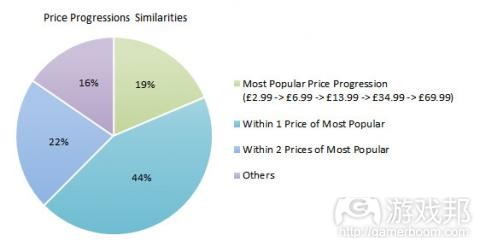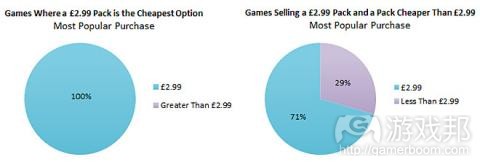免费手机游戏使用的5种付费货币定价技巧
作者:Wolfgang Graebner
大多数手机上的免费游戏都会出售一些付费货币:如《部落战争》中的宝石,《辛普森一家:枯竭》的甜甜圈,《战争游戏》中的金币等等。我投入了一些时间去分析App Store上的32款游戏是如何出售它们的付费货币,以及从中出现的一些有趣的趋势和技巧。
游戏
在开始前请先看看我的数据集。我们将分析的32款游戏是:
《美式台球》,《怒鸟向前冲》,《海岛奇兵》,《王国传奇》,《部落战争》,《笨拙的忍者》,《CSR赛车》,《迪斯科动物园》,《地下城守护者》,《帝国》,《农场英雄传奇》,《战争游戏》,《卡通农场》,《霍比特人:中土王者》,《果冻爆破》,《果汁方块》,《战争王国》,《亚瑟王国》,《骑士与龙》,《现代战争》,《怪兽世界》,《莫希怪兽村》,《帕帕弹珠传奇》,《口袋小镇》,《智龙迷城》,《真实赛车》,《皇家起义2》,《武士围攻》,《辛普森一家:枯竭》,《蓝精灵的村庄》,《地铁跑酷》,《足球经理》。
我选择这些游戏的方法并不符合什么科学原理,只是挑选了我自己玩过,想玩,或者来自App Store畅销游戏排行榜的游戏。也许在今后我将进一步扩展这一列表。
趋势和技巧
1)存在各种各样的定价
许多游戏呈现出了5种价格点:2.99英镑,6.99英镑,13.99英镑,34.99英镑以及69.99英镑。这是你在上述图表中会看到的5个大泡泡。
(游戏邦注:对于美国读者来说就是4.99美元,9.99美元,19.99美元,49.99美元以及99.99美元)。
最受欢迎的情况便是不作任何改变地提供这5种价格点,就像Supercell的《海岛奇兵》那样。
这样的价格推进实际上只占据所有被调查游戏的1/5。
如果你同样也算上最受欢迎的1种价格(即它们可以通过推进添加,修改或减去1种价格)中的游戏,你将能够包含其中3/5的游戏。
再一次扩展去计算2个价格中的价格推进,这时候你便能够包含几乎所有被调查的游戏了。
很少游戏会偏离这一公式。《莫希怪兽村》和《帝国》便并列拥有最独特的价格点,它们分别提供了其它游戏并不具有的4种独特的价格。看到人们尝试着一些不同的内容总是很让人兴奋,而看着它们的定价方式开始变得受欢迎也非常有趣。
2)玩家同意最小定价,但是发行商却不同意
似乎游戏并不认同的唯一价格便是最小定价。
我想知道:提供低于2.99英镑的最小定价是否值得?App Store最受欢迎的购买排行揭示了一些有趣的信息。
1.在关于2.99英镑是最低价格的100%例子中,这也是最受欢迎的购买对象。
2.17款游戏既带有低于2.99英镑的起步价,也带有2.99英镑的基本价格点。
3.对于这17款游戏中的大多数游戏(70%),2.99英镑仍然是最受欢迎的价格点。
让我们通过图表了解同样的信息:
我们清楚如果你提供给玩家低于2.99英镑的最低价格点,他们便有可能仍然选择花2.99英镑购买游戏。但这时候也仍然存在一些疑问。
a)当2.99英镑是最便宜的选择时,你会因为那些只愿意花低于2.99英镑的钱去购买游戏的玩家而损失多少销量?
b)你会从那些更愿意看到更低价格,但却因为别无选择而只能花2.99英镑购买游戏的玩家身上获得多少收益?
c)最重要的是,哪种情况更好?a还是b?
不幸的是,我并未拥有足够的数据去回答这一问题。但这的确让我想起了很早以前我听到的一个发行商关于:“你会因为那些愿意花1美元购买某些内容同时也会愿意花5美元去购买这些内容的玩家数量感到惊讶”的演讲。他也传达了将价格定得过低的悔恨。
如果是由我做决定,我可能会选择从2.99英镑开始,并在之后通过提供一些特别的游戏包而降低价格。比起提升价格,降低价格总是更简单。
3)对于玩家来说买更多通常都不是一个更好的注意
假设我购买了一个更大的货币包,我将在每次花费真钱时获得更多货币。情况并非总是如此。我所遇到的最主要的例子便是《怒鸟向前冲》:
支付2.5倍的钱却只获得2.1倍的宝石。如果你想要2500个宝石,你便可以通过花费29.97英镑购买2×1200个宝石+1×100个宝石,这比基于34.99英镑的2500个宝石定价便宜了5英镑。你可以用省下来的钱去购买另外300颗宝石。
这并不是一个特殊的情况。我们所调查的70%的游戏都会这么做。
有时候你甚至会在美国的商店中也看到类似的情况。
我认为这与价格本土化也有关。当某些内容在美国的定价是4.99美元时,它在英国的售价通常都是2.99英镑。但出于某些原因,9.99美元的游戏到英国有可能变成6.99英镑,而不是5.99英镑。例如《卡通农场》。
我不清楚为何会出现这种情况,但我也未看到任何游戏在调整这些付费货币,所以有时候我仍会看到花费每1英镑所获得的货币少于花费1美元所获得的货币。
4)“最受欢迎”并不一定意味着最受欢迎
作为一名玩家,请不要相信发行商告诉你的一切。8款游戏中只有1款游戏会在货币包旁边呈现出“最受欢迎”的标志,这也是App Store排行中最受欢迎的购买。
《怒鸟向前冲》是唯一一款准确标注出“最受欢迎”记号的游戏:
这是否意味着其它游戏在撒谎?我认为如果是在过去或者在不同领域,看到被标记为“最受欢迎”的内容是真正最受欢迎的内容,你便会认为这是一种过时的做法。
不管怎样,这并非任何发行商的最大兴趣,因为在所有的7个例子中,即贴错“最受欢迎”标签的内容,更低的报价更受欢迎,而谁会想要鼓励玩家去购买更廉价的货币包呢?显然只有Rovio够诚实。
5)存在1种以上的方法能够计算奖励
有些游戏喜欢告诉玩家更大的货币包能够成就更好的交易。存在不同方法去衡量怎样做能让折扣听起来更吸引人(或相反)。
第一个例子是来自Kabam的《霍比特人》游戏。
6.99英镑的货币包中有每1英镑最少的宝石:100/6.99=每1英镑14.3货币
基于这一交换率,你使用13.99英镑将获得13.99x 14.3 = 200货币。
但是游戏将提供给你240个货币去换取你的13.99英镑,而不是200个货币。
240/200=1.2,因此你将比应获得的货币还多20%的货币。
这样的数字既能最大化奖励的吸引力,同时也能够保持100%的真实性。并非所有人都能够基于同样的方式进行计算。
以下是另一个例子,即来自flare的《皇家起义2》。
与《霍比特人》一样,它们也在6.99英镑的货币包中使用了最低交换率。
基于这一比率,你将能够使用34.99英镑换取5256个货币,但是他们却给了你7500个货币。
这便是该方法与《霍比特人》的不同之处。
游戏额外提供的货币数是7500-5256=2244。
2244/7500=0.2999,所以我可以说你获得了29%的免费货币。
首先,他们可以轻松地将29.9%四舍五入到30%。更重要的是,使用《霍比特人》的方法你可以说7500/5256=1.43,也就是你获得额外的43%的货币。
另外一个有趣的例子是《怪兽世界》。
如果你尝试着使用同样的方法去计算奖励,那是行不通的。我暂时被难住了。然后我检查了美国App Store的价格,发现它们是依序排列。
如果你使用了美国的价格,那么使用与《霍比特人》同样的方法便行得通。如此看来当定价进行本土化时,奖励并不是如此。实际上,英国App Store的奖励不及美国App Store慷慨。
结论
我希望这些信息能够帮助任何致力于免费游戏付费货币定价的人。我们应该更深入地去了解定价,如此才能发现更多有帮助的信息。
(本文为游戏邦/gamerboom.com编译,拒绝任何不保留版权的转功,如需转载请联系:游戏邦)
5 Premium Currency Pricing Trends and Tricks used by Mobile Free-To-Play Games
By Wolfgang Graebner
Most free-to-play games on mobile sell some sort of premium currency: gems in Clash of Clans, donuts in Simpsons Tapped Out, gold in Game of War and so on. I spent some time analysing how 32 games on the App Store sell their premium currency, and some interesting trends and tricks emerged.
The Games
Before we proceed, meet my data set. The 32 games analyzed are:
8 Ball Pool, Angry Birds Go!, Boom Beach, CastleVille Legends, Clash of Clans, Clumsy Ninja, CSR Racing, Disco Zoo, Dungeon Keeper, Empire, Farm Heroes Saga, Game of War, Hay Day, Hobbit: KoM, Jelly Splash, Juice Cubes, Kingdoms at War, Kingdoms of Camelot, Knights & Dragons, Modern War, Monster World, Moshi Monsters Village, Papa Pear Saga, Pocket Village, Puzzle & Dragons, Real Racing, Royal Revolt 2, Samurai Siege, Simpsons Tapped Out, Smurf’s Village, Subway Surfers, Top Eleven.
My method for selecting games was pretty unscientific… just a mix of games I had played, wanted to play, or were in the AppStore top grossing. Perhaps I’ll expand on the list some day.
Trends & Tricks
1) There is not much variety in pricing
Attached Image: pricing_trends.jpg
A lot of games offer the same 5 price points: £2.99, £6.99, £13.99, £34.99, £69.99. Those are the 5 big bubbles you see in the diagram above.
(That’s $4.99, $9.99, $19.99, $49.99, $99.99 for American readers).
The most popular thing to do is to offer those 5 price points exactly with no changes, as is done in Supercell’s Boom Beach for example.
Attached Image: boombeachprices.jpg
This exact price progression accounts for 1/5th of all games surveyed.
If you also count price progressions that are within 1 price of the most popular (meaning they can be reached by either adding, modifying or subtracting just 1 price from the progression), you’ve got over 3/5ths covered.
Extend it again to count price progressions within 2 prices and almost all games are accounted for.
Attached Image: price_progression_similarity.jpg
Very few games deviate from this formula… Moshi Monsters Village and Empire are tied for the most unique price points award, with each offering 4 unique prices that no other game does. It’s nice to see someone trying something a little different, it will be interesting to see if their pricing catches on.
2) Players agree on a minimum price, publishers don’t
The only price that games seem to disagree on is the minimum to charge.
Attached Image: cheapest_price.jpg
I wanted to know: is it worth offering a minimum price cheaper than £2.99? The App Store most popular purchase ranking reveals some interesting information.
1.In 100% of cases where £2.99 is the cheapest price, it is also the most popular purchase.
2.17 games had both a starting price cheaper than £2.99, as well as a price point at £2.99.
3.For the majority (70%) of those 17 games, £2.99 was still the most popular price point.
The same information visualized:
Attached Image: popularpurchases_299.jpg
It appears that even if you offer players a minimum price point cheaper than £2.99, chances are they will probably still prefer to buy the £2.99 option. But some questions remain…
a) When £2.99 is the cheapest option, how many sales are lost from players only willing to pay less than £2.99?
b) And how much revenue is gained from players that would have preferred a cheaper option but paid £2.99 anyways because there was no cheaper option?
c) And most importantly, which is greater? A or B?
Unfortunately I don’t have enough data to answer it. But it did make me think back to a talk I watched long ago in which a publisher claimed “you’d be surprised how many people who are willing to pay a dollar for something, will also be willing to pay 5 dollars“. He goes on to express regret for setting the price too low.
If it was up to me, I would probably start pricing at £2.99 and then lower the price later through special starter pack offers if need be. It’s always easier to lower a price than it is to raise it!
3) Buying more is not always a better deal for the player
I assumed that by buying a larger currency pack, I would always get more currency per dollar spent. This is not always the case. The most significant example of this I came across was in Angry Birds Go:
Attached Image: angrybirdspricepergem.jpg
Pay 2.5 times as much, but only get 2.1 times as many gems. If you want 2,500 gems, you can save money by buying 2 x 1,200 gems + 1 x 100 gems for a total cost of £29.97 – a whole £5 cheaper than the 2,500 gems priced at £34.99. Those are savings you could use to buy another 300 gems.
It’s hardly an isolated incident. 70% of the games surveyed do this kind of thing.
Sometimes, you see the same thing happening in the US store.
Attached Image: angrybirdsgo_us_price.jpg
Other times I think it has to do with price localization. When something is priced at $4.99 in the US it is typically sold for £2.99 in the UK. But for some reason $9.99 (double 4.99) becomes £6.99 (more than double £2.99) whereas it really should be £5.99. Take Hay Day for example.
Attached Image: hayday_usuk_pricecomparison.jpg
Not sure how or why this practice originated, but I didn’t see any games adjust the premium currency given as a result so sometimes we end up getting less currency per £1 than you would get per $1.
4) ‘Most popular’ doesn’t have to mean most popular
As a player, don’t trust everything publishers tell you. In only 1 out of 8 games that prominently displayed a “Most Popular” badge next to a currency pack, was that also the actual most popular purchase in the App Store ranking.
Angry Birds Go, the only one to correctly label the “Most Popular” offer:
Attached Image: angrybirdsgomostpopular.jpg
Does this mean everybody else is lying? I guess if at some point in the past or in a different territory the offer tagged as “Most Popular” was actually most popular, then you could say it’s just out of date.
In any case, it wouldn’t be in any publisher’s best interest because in all 7 cases where the “Most Popular” was mislabeled, a cheaper offer was the most popular and who would want to encourage players to buy a cheaper pack? Apparently only Rovio is honest enough.
5) There’s more than 1 way to calculate a bonus
A few games like to tell players exactly how much of a better deal the larger currency packs are. There are different ways of calculating this which can make the discount sound more or less impressive.
Attached Image: bonuscalculation_hobbit.jpg
This first example is from Kabam’s Hobbit game.
The lowest amount of gems per £1 is found in the £6.99 pack: 100 / 6.99 = 14.3 currency per £1.
At this exchange rate, for £13.99 you should get 13.99 x 14.3 = 200 currency.
But they give you 240 for £13.99 instead of 200.
240 / 200 = 1.2, thus you are getting 120%, ie 20% more than you should get.
The numbers have been arranged so as to maximize how impressive the bonus sounds while remaining 100% truthful. Not everybody calculates it the same way.
Here’s a different example from flare’s Royal Revolt 2.
Attached Image: bonuscalculation_rr2.jpg
Like Hobbit, they use the lowest exchange rate which again is from the £6.99 pack.
At that rate, you should get 5,256 currency for £34.99 but instead they give you 7,500.
This is where the method diverges from Hobbit.
The extra amount of currency being given is 7,500 – 5,256 = 2,244.
2,244 / 7,500 = 0.299, so we can say that of the 7,500 currency you are being given 29% for free.
First off, they could easily have rounded 29.9% up to 30%. More significantly, using Hobbit’s method you could say that 7,500 / 5,256 = 1.43, therefore it is equally honest to say that you are getting 43% extra.
Another interesting example is Monster World.
Attached Image: bonuscalculation_monsterworld.jpg
If you try to calculate the bonus using any sane method, it just doesn’t make sense. It had me stumped for a little while. Then I checked the US AppStore pricing and it all fell into place.
Attached Image: mopnsterworld_USprices.jpg
If you use the US prices, the bonuses make perfect sense using the same method as Hobbit. So it appears that when the prices were localized, the bonuses were not. In reality, the bonuses in the UK AppStore are far less generous than their US counterparts (eg 7% UK instead of 25% US for 100 potions and 70% UK instead of 100% US for 4,000 potions).
Final Words
I hope this information helps anyone working on (or simply curious about) f2p game premium currency pricing. There’s certainly a lot more going on with the prices than is obvious at first glance. The more I looked, the more I found.
Still not satisfied? Try my spreadsheet. It’s full of extra figures and graphs I didn’t consider important enough to single out. And if you find something in the data I missed, let us know!(source:gamedev)














































 闽公网安备35020302001549号
闽公网安备35020302001549号